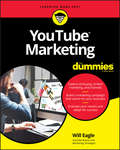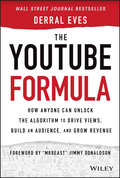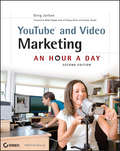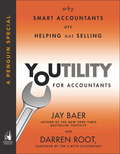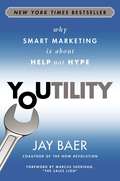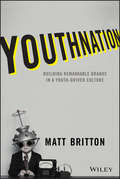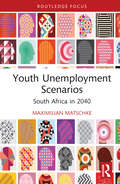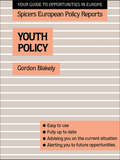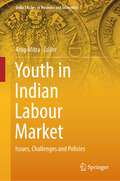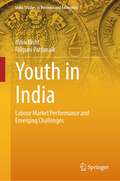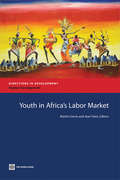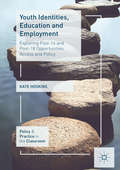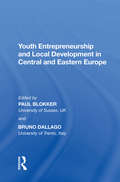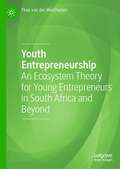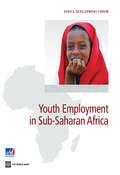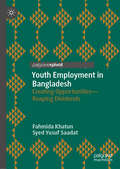- Table View
- List View
YouTube Marketing For Dummies
by Will EagleAdvice from a YouTube insider on how to creative effective campaigns YouTube is the top destination for online video. With over a billion viewers around the globe, it's also valuable real estate for marketers looking to get their message out. YouTube Marketing For Dummies shares insight from a former YouTube employee who helped large and small businesses create effective marketing campaigns. Inside, you’ll discover proven game plans for buying advertising, launching a content marketing campaign, building a branded channel and community, and evaluating the results of your work. Plus, you’ll find trusted, proven ways to get the most bang for your buck from the internet’s #1 destination for video content. Create a plan that fits your business needs Launch an ad campaign Find video creation strategies Launch a branded channel Are you ready to identify, launch, and measure a YouTube marketing campaign? Everything you need is a page away!
YouTube Marketing: Comprehensive Beginner's Guide to Learn Youtube Marketing from A to Z
by Jack SanchezYoutube Marketing: Comprehensive beginners guide to learn Youtube marketing from A to Z
The YouTube Formula: How Anyone Can Unlock the Algorithm to Drive Views, Build an Audience, and Grow Revenue
by Derral EvesLearn the secrets to getting dramatic results on YouTube Derral Eves has generated over 60 billion views on YouTube and helped 24 channels grow to one million subscribers from zero. In The YouTube Formula: How Anyone Can Unlock the Algorithm to Drive Views, Build an Audience, and Grow Revenue, the owner of the largest YouTube how-to channel provides the secrets to getting the results that every YouTube creator and strategist wants. Eves will reveal what readers can't get anywhere else: the inner workings of the YouTube algorithm that's responsible for determining success on the platform, and how creators can use it to their advantage. Full of actionable advice and concrete strategies, this book teaches readers how to: Launch a channel Create life-changing content Drive rapid view and subscriber growth Build a brand and increase engagement Improve searchability Monetize content and audience Replete with case studies and information from successful YouTube creators, The YouTube Formula is perfect for any creator, entrepreneur, social media strategist, and brand manager who hopes to see real commercial results from their work on the platform.
YouTube and Video Marketing
by Greg JarboeFully updated with new information, including the latest changes to YouTube! If you're a marketer, consultant, or small business owner, this is the guide you need to understand video marketing tactics, develop a strategy, implement the campaign, and measure results. You'll find extensive coverage of keyword strategies, tips on optimizing your video, distribution and promotion tactics, YouTube advertising opportunities, and crucial metrics and analysis. Avoid errors, create a dynamite campaign, and break it all down in achievable tasks with this practical, hour-a-day, do-it-yourself guide. Shows you how to successfully develop, implement, and measure a successful video marketing strategy Written in the popular An Hour a Day format, which breaks intimidating topics down to easily approachable tasks Thoroughly updated with the latest YouTube functionality, helpful new case studies, the latest marketing insights, and more Covers optimization strategies, distribution techniques, community promotion tactics, and more Explores the crucial keyword development phase and best practices for creating and maintaining a presence on YouTube via brand channel development and customization Shows you how to optimize video for YouTube and search engine visibility Give your organization a visible, vital, video presence online with YouTube and Video Marketing: An Hour a Day, Second Edition.
YouTube and Video Marketing
by Greg Jarboe Suzie ReiderA complete, task-based guide to developing, implementing, and tracking a video marketing strategyOnline video marketing is crucial in today's marketplace. This guide teaches you proven, practical guidelines for developing and implementing video marketing for your organization.If you're a marketer, advertising professional, consultant, or small business owner, here's a relevant guide to understanding video marketing tactics, developing a strategy, implementing the campaign, and then measuring results. You'll find extensive coverage of keyword strategies and video optimization, distribution and promotion strategies to other sites and blogs, YouTube advertising opportunities, and crucial metrics and analysis.Written in the popular "Hour a Day" format, which breaks intimidating topics down to easily approachable tasks Covers previously undocumented optimization strategies, distribution techniques, community promotion tactics, and more Explores the crucial keyword development phase and best practices for creating and maintaining a presence on YouTube via brand channel development and customization Examines effective promotional tactics, how to optimize video for YouTube and search engine visibility, and metrics and analytics Includes case studies, additional resources, a glossary, information about creating and editing video, step-by-step guides, and valuable tutorials YouTube and Video Marketing: An Hour A Day gives you the tools to give your clients or your organization a visible, vital marketing presence online
YouTube: Time to Charge Users?
by Sunil Gupta Anita ElberseIn January 2010, YouTube, the world's largest online video aggregator, was still seeking to become profitable. Was the time right for Google, YouTube's parent company, to charge users seeking to upload content, as some analysts had suggested - and if so, who should be charged how much and for what? Could YouTube charge users for downloading content, a model it was now beginning to test? Or would it be better for the online video giant to continue to pursue an advertising model, but perhaps broaden its services to advertisers? Describes the online video market as of 2010 as well as YouTube's offerings to users, content owners, and advertisers. Provides information on the site's revenues and costs. Also contains detailed data on online video users and usage behavior.
Youtility for Real Estate
by Jay Baer Erica Campbell ByrumHow real estate professionals can build trust and dominate their competition by creating truly useful marketing. Youtility, as defined by bestselling author Jay Baer, is marketing that people cherish instead of marketing they simply tolerate. Due to enormous shifts in technology and consumer behavior, customers want a new approach that cuts through the clutter: marketing that is truly, inherently useful. Smart real estate professionals are applying the concepts of Youtility, giving away information and resources for free, to differentiate and dominate by providing real value to clients and prospective clients. The difference between helping and selling is just two letters, but embracing the former makes the latter much, much easier. Meticulously researched and filled with examples of residential and multifamily real estate professionals who have accelerated their businesses enormously by embracing the principles of Youtility marketing, this special e-book provides a groundbreaking plan for using information and helpfulness to transform the relationship between real estate pros and their customers. Based on the New York Times bestseller Youtility, this pithy e-book is a must for marketers in the real estate industry.
Youtility for Accountants
by Jay Baer Darren RootYoutility fundamentally changes how accountants and accounting firms think about marketing and their business. Jay Baer defines "Youtility" as information and resources given away for free to build awareness and trust. Youtility creates awareness, customers, and loyalty over the long-term. Due to enormous shifts in technology and consumer behavior, customers want a new approach that cuts through the clutter: marketing that is truly, inherently useful. The difference between helping and selling is just two letters, but embracing the former makes the latter much, much easier. Meticulously researched, and filled with examples of accountants and accounting firms that have accelerated their business enormously by embracing the principle of Youtility marketing, this special ebook from best selling authors Jay Baer and Darren Root provides a groundbreaking plan for using information and helpfulness to transform the relationship between companies and customers. Based on the New York Times best seller Youtility, this is the playbook for modern marketing effectiveness in the accounting industry.
Youtility: Why Smart Marketing Is about Help Not Hype
by Jay BaerThe difference between helping and selling is just two letters If you're wondering how to make your products seem more exciting online, you're asking the wrong question. <P><P>You're not competing for attention only against other similar products. You're competing against your customers' friends and family and viral videos and cute puppies. To win attention these days you must ask a different question: "How can we help?" Jay Baer's Youtility offers a new approach that cuts through the clutter: marketing that is truly, inherently useful. If you sell something, you make a customer today, but if you genuinely help someone, you create a customer for life.
YouthNation: Building Remarkable Brands in a Youth-Driven Culture
by Matt BrittonYouth is no longer an age—it's a commodity YouthNation is an indispensable brand roadmap to the youth-driven economy. Exploring the idea that youth is no longer an age—it's a commodity that's available to everyone—this book shows what it takes to stay connected, agile, authentic, and relevant in today's marketplace. Readers will learn the ins and outs of the new consumer, and the tools, methods, and techniques that ensure brand survival in the age of perpetual youth. Coverage includes marketing in a post-demographic world, crafting the story of the brand, building engaged communities, creating experiences that inspire loyalty and evangelism, and the cutting-edge tricks that help businesses large and small harness the enormous power of youth. The old marketing models are over, and the status quo is dead. Businesses today have to embody the ideals of youth culture in order to succeed, by tapping the new and rapidly evolving resources n business and in life. When everything is changing at the pace of a teenager's attention span, how do businesses future-fit for long-term success? This book provides a plan, and the thoughts, strategies, and brass tacks advice for putting it into action. Use New-Gen psychographics to target markets Build stronger evangelism with a compelling brand narrative Create loyal communities with immersive and engaging experiences Navigate the radically-changed landscape of the future marketplace In today's hyper-socialized, Facebook fanatic, selfie-obsessed world, youth is the primary driver of business and culture. Smart companies are looking to tap into the fountain of youth, and the others are sinking fast. YouthNation is a roadmap to brand relevancy in the new economy, giving businesses turn-by-turn direction to their market destination.
Youth Villages
by William Foster Allen Grossman Catherine RossTennessee-based nonprofit Youth Villages had an impressive record of serving emotionally and behaviorally troubled youth and their families, with higher success rates and lower costs than most child services providers. Yet expanding to offer its services on a broader scale proved challenging.
Youth Unemployment Scenarios: South Africa in 2040 (Routledge Contemporary South Africa)
by Maximilian MatschkeThis book examines the factors driving youth unemployment in South Africa, exploring potential future outcomes of its mass unemployment, and offering a variety of strategies to avoid an impending crisis in the country. Utilizing scenario analysis rooted in complex systems theory while building on statistical and fi eld research, the author illustrates four possible future states of youth employment in South Africa in the year 2040. This includes the South African version of the Arab Spring, where young people riot or agitate for extreme political and social change because of a belief that access to education and jobs is only possible through social status or corruption (Spring), fair access to a high number of jobs supported by Chinese interventions (Summer), a technology- driven decline in the number of jobs where merit- based access for youth is granted (Fall), and the collapse of the economy, with the economy collapsing and youth becoming increasingly desperate (Winter). The author then presents five strategies to fight youth unemployment, including training of youth to start businesses, stimulating small- and medium- sized enterprises, and sending unemployed youth abroad for skills development and to where their labour is needed. This book will be of interest to scholars of South African politics and economics, labour economics and youth studies, and readers with an interest in tackling youth unemployment independent of the country.
Youth Tourism to Israel
by Erik H. CohenThis book is a cumulative analysis of an international, longitudinal study of a tour program which brings Jewish youth from around the world to Israel. It is a case study of the longest running and most thoroughly documented, intentionally organized heritage tour program in existence, including a wealth of data never previously published. Issues central to Jewish studies are explored in depth, including cross-cultural analysis of the impact and meaning of the program in Jewish communities around the world. Additionally, it touches on core issues related to identity in the post-modern era, the sociology of contemporary tourism, and informal education and adolescent psychology and sociology. The book is relevant to researchers, professionals and university students in the fields of Jewish studies and tourism.
Youth Policy (Spicers European Policy Reports)
by Gordon BlakelyEuropean co-operation has a special role in relation to youth. Both the Council of Europe and the European Community have developed specific initiatives to promote the interests of youth, and to place them in a European-wide context. These initiatives cover economic, social, educational and cultural matters. New opportunities have been created for youth exchanges and an increasingly important application of the EC Social Fund is concerned with youth issues. This volume has a wider focus than the others in this series in that it covers the initiatives of both the European Community and some of the work done by the Council of Europe. It explains how their youth policies have developed, the differences between them, it guides the reader as to its current programmes, and it also discusses proposals affecting the immediate future. This volume will be of special interest to the diverse audience concerned with youth policy: public administrators, educationalists, social and cultural bodies, youth representatives and young individuals.
Youth in Indian Labour Market: Issues, Challenges and Policies (India Studies in Business and Economics)
by Arup MitraThis book addresses labour market participation issues of youth in India, and follows an inter-disciplinary approach. It carries out both quantitative and qualitative assessments for an in-depth understanding of these issues. It collates a wide range of concerns both from supply and demand side, and instead of reflecting on the empirical questions only, the book reflects on various analytical questions as well. Some other challenges being discussed here are inadequacy of skill and compulsion to participate in the labour market, concentration in activities with excess supplies of labour, unrecognised work experience, lack of upward mobility, and working with information asymmetry. Caste and gender disadvantages are an instrumental part of the book. Problems of educated and uneducated youth are quite different and the book analyses them separately. Besides, it refers to a wide range of issues relating to occupational flexibility. It also discusses skill imparting institutions and themajor lacuna associated with their functioning. Social unrest and threats to the prospects of future growth in the absence of adequate youth employment are some of the economic and political issues which the book covers. Unraveling the threads of the concerns mentioned above, the book finally comes up with policy suggestions. It is a great resource for researchers, industry watchers, and policy makers who are interested in inclusive and sustainable growth.
Youth in India: Labour Market Performance and Emerging Challenges (India Studies in Business and Economics)
by Nitin Bisht Falguni PattanaikThis book provides an overview of youth labour force and workforce participation in India and explores the dynamics of changing youth labour market in India. Despite notifying a demographic dividend phase, a significant share of youth witnessed higher exclusion (unemployment and not in employment, education or training) from the Indian labour market. Therefore, this book investigates the role of education in labour market and examines open unemployment. It conceptualizes the not-in-employment-education-or-training (NEET) status of youth in Indian context and explores the heterogeneity of NEET youth by analysing the push and pull role of demographic and socio-economic variables. Furthermore, this book examines the nexus of youth labour market status and economic growth in India to provide plausible recommendations for youth's higher, inclusive and sustained participation in the labour market and the country's development pathway. The book creates room for necessary policy interventions considering the changing dynamics of youth labour market and contemplating the challenges of skill, technology and Industry 4.0., which entails a higher emphasis on ‘re-shape’, ‘re-focus’ and ‘re-share’ for enhanced and sustained inclusion of youth in labour market. It is a necessary resource for students, researchers, policymakers, and industry partners interested in exploring and understanding the political economy of youth labour market in India.
Youth in Contemporary India
by Parul BansalThis book endeavors to be a study of identity in Indian urban youth. It is concerned with understanding the psychological themes of conformity, rebellion, individuation, relatedness, initiative and ideological values which pervade youths' search for identity within the Indian cultural milieu, specifically the Indian family. In its essence, the book attempts to explore how in contemporary India the emerging sense of individuality in youth is seeking its own balance of relationality with parental figures and cohesion with social order. The research questions are addressed to two groups of young men and women in the age group of 20-29 years-Youth in Corporate sector and Youth in Non Profit sector. Methodologically, the study is a psychoanalytically informed, process oriented, context sensitive work that proceeds via narrations, conversations and in-depth life stories of young men and women. Overall, the text reflects on the nature of inter-generational continuity and shifts in India.
Youth in Africa's Labor Market
by Jean Fares Marito H. GarciaThe authors examine the challenges facing Africa's youth in their transition from school to working life, and propose a policy framework for meeting these challenges. Topics covered include the effect of education on employment and income, broadening employment opportunities, and enhancing youth capabilities.
Youth Identities, Education and Employment
by Kate HoskinsThis book investigates how policy, family background, social class, gender and ethnicity influence young people's post-16 and post-18 employment and education access. It draws on existing literature, alongside new data gathered from a case study in a UK state secondary school, to examine how policy changes to the financial arrangements for further and higher education and the changing youth employment landscape have had an impact on young people's choices and pathways. Hoskins explores a number of topics, including the role of identity in young people's decision-making; the impact of changes to young people's financial arrangements, such as cuts to the Education Maintenance Allowance and increased university fees; and the influence of support from parents and teachers. The book will be of interest to students and researchers of Education and Sociology.
The Youth Experience Gap
by Francesco Pastore"The education to work transition of young people is key to a successful work-life and to fight youth unemployment. The book provides an impressive outline of the facts and convincing insights of the potential causes. This offers a large and broader audience help to adjust properly to achieve a better life. " Klaus F. Zimmermann, IZA, Bonn, Germany This work points to the youth experience gap as a key concept to explain the meager employment opportunities and earnings many young people face. The transition from education to work remains a long dark tunnel around the world. However, this book shows that there are striking differences between countries: in Germany, the young people of today are no worse off than their adult counterparts, while in Southern European and Eastern European countries they fare 3 through 4 times worse. The current economic and financial crisis has further exacerbated the situation for young people in many advanced economies. Observers are divided as to the optimal design of youth employment policy. Liberalists believe that the market itself should address youth disadvantages. More flexible labor markets should also guarantee greater labor turnover, including temporary work, so as to allow young people to move from one job to the next until they accumulate the work experience they need to become more employable and find the right career. In contrast, other economists oppose approaches focusing on entry flexibility and temporary work, claiming that the former type helps only the most skilled and motivated target groups, while the latter only allows young people to gather generic, not job-specific work experience.
Youth Entrepreneurship and Local Development in Central and Eastern Europe
by Bruno DallagoThis book analyses the opportunities and barriers for youth entrepreneurship amid systemic change in Central and Eastern Europe. The authors cover different aspects of youth entrepreneurship and its contribution to the debate on youth unemployment in transition economies. The book discusses the wide-spread over-optimism regarding youth entrepreneurship, self-employment, and its impact on economic innovation and job creation, resulting from a disregard of critical contextual features and the characteristics of young entrepreneurs themselves. The authors give due acknowledgment of the importance of both factors and so fully understand the impediments to youth entrepreneurship, especially in a transition context. Furthermore, they seek to assess the opportunities and constraints of promotion policies in transition economies. Most importantly, the book provides the first empirical contribution to youth entrepreneurship in Central and Eastern Europe by offering a representative number of case studies. The book will be invaluable reading for scholars and students of transition and developing countries, particularly those with an interest in entrepreneurship.
Youth Entrepreneurship: An Ecosystem Theory for Young Entrepreneurs in South Africa and Beyond
by Thea van der WesthuizenAddressing the theoretical and practical gaps in our knowledge around developing internal and external domains of youth entrepreneurship, the book places particular emphasis on South Africa, but offers insights and implications that can be applied far beyond our borders. It makes the case that it is possible to develop internal domains through various models. These models include ‘shifting hope activating potential entrepreneurship’ (SHAPE), ‘youth entrepreneur support’ (YES), and ‘systemic action learning and action research’ (SALAR). Validated through a series of assessments, these models were created as a basis for the development and application of a youth entrepreneurship ecosystem for university students. The study presented in this book describes the development of a youth entrepreneur support network to sustain Individual Entrepreneurial Orientation development among students. It provides insights into a framework and model that can be simulated at other institutions, organisations and youth entrepreneurship development programmes. A useful resource for academics and post-graduate students, the book provides valuable insights on how to develop, implement, apply and monitor new models and best practices to support youth entrepreneurs’ journey on route to entrepreneurial action.
Youth Employment in Sub-Saharan Africa
by Deon Filmer Louise Fox Karen Brooks Aparajita Goyal Taye Mengistae Patrick Premand Dena Ringold Siddharth Sharma Sergiy ZoryaHigh fertility and declining mortality rates have led to a very young population in most Sub-Saharan African countries. The region?s labor force is expected to increase by 11 million people per year over the next 10 years. Most of this increase will be new entrants seeking their first job. While the younger generation is better educated than their parents, they often lack the means to translate that education into productive employment. Today, most work is in nonwage jobs on farms and in household enterprises. Even if greater economic activity were to create the conditions for robust growth and economic transformation, the private modern wage sector in low- and lower-middle-income countries could not absorb all the applicants. This report focuses on how to improve the quality of all jobs and to meet the aspirations of youth. It emphasizes that building a strong foundation for human capital development can play an important role in boosting earnings, and it argues that a balanced approach focusedon building skills, raising productivity, and increasing the demand for labor is necessary. Youth Employment in Sub-Saharan Africa notes that many youth employment challenges are problems of employment in general. However, youth is a time of transition, and young people face particular constraints to accessing productive work. The report brings together original analysis of household and labor force surveys; it reviews the experience of a number of promising interventions across the continent; it draws from qualitativestudies in several countries; and it surveys the most up-to-date evidence from rigorous evaluations of policies and programs. From this information base, the report provides guidance to policy makers on how to intervene along two dimensions?human capital and the business environment?and in three priority areas?agriculture, household enterprises, and the modern wage sector. The ultimate goals are to increase productivity, improve livelihoods, and multiply opportunities for young people.
Youth Employment in Bangladesh: Creating Opportunities—Reaping Dividends
by Fahmida Khatun Syed Yusuf SaadatThis book brings together pioneering and evidence-based research that focuses on youth employment—one of the foremost development challenges of our time—and fills a critical research and knowledge gap alongside consolidating existing relevant literature. Comprehensive in scope, the book provides an overview of trends in youth employment in Bangladesh, empirically analyses the determinants of youth unemployment, covers relevant economic theory, and recommends policy measures for employment creation in Bangladesh. The new evidence from Bangladesh on the aforesaid issues will inform relevant and concurrent policy discourse, add value to related research in the field, and inspire future research. The insights gathered through this study will serve as an important lesson for other developing countries on what works and what does not in policy-making.
